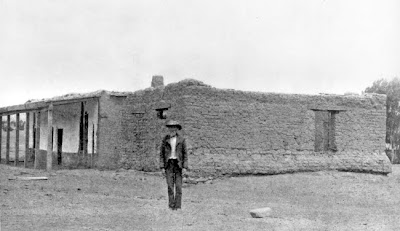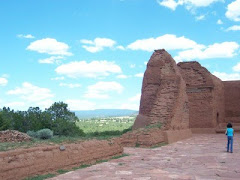On March 26, 1862, Confederate and Union soldiers stopped at each end of Glorieta pass - the Confederates at Apache Canyon to the west and the Federals at Pigeon’s Ranch to the east.
The two forces then briefly clashed near the Confederate base at Apache Canyon
before retiring to their respective camps.
Hostilities resumed the morning of March 28th, as both sides advanced into Glorieta Pass. The Confederates chose to send most of their forces into the attack, and left perhaps 30 or 40 troops to guard the supply train in the rear of Apache Canyon at Johnson’s Ranch. Four hundred Colorado Volunteers descended from the steep mountains late in the day and surprised the far outnumbered Confederate rear guard at Johnson‘s Ranch.
The Federals quickly overwhelmed the Rebels and burned all 85 wagons in the Confederate supply train. The Union forces also drove off more than 500 horses and pack mules. This pretty much crippled the Confederates.
Even though the rebels had an advantage in numbers and they pushed the Federals back toward the eastern edge of the pass, at one point shelling the Federal camp at Pigeon’s Ranch,
they still had to retreat because of what the Union had done to their supply wagons. They were, after all, in New Mexico, and whatever they needed they had to have with them--especially water and food, but also saddles, medicines, ammunition. Without their supplies, the Confederates had no choice but to retire from the field and withdraw to Santa Fe. Soon they pulled out of New Mexico territory for good.
The Confederate leaders thought they could manage to live off the land and they thought westerners would rally to their cause. They were wrong on both counts.










 It is believed that they originally served as kin group meeting places or even dwelling units and then later became religious centers. Many were aligned with entrances and vent shafts running due north and south.
It is believed that they originally served as kin group meeting places or even dwelling units and then later became religious centers. Many were aligned with entrances and vent shafts running due north and south. The sipapu represents the emergence place, the walls the sky, and the roof the Milky Way (Malville 8). In fact some kivas belonging to the Pueblo Indians had complex wall paintings displaying astronomical symbols (Williamson 190) [we have not seen this in our kiva travels]. The roof of the kiva was typically supported by four posts, which according to Malville, could have represented the four cardinal directions, "the four trees planted in the underworld or the four sacred mountains" (8). Even the ladder used to climb into and out of the kiva could be considered a symbol of the emergence with the ritualization of emergence being performed whenever someone climbed out of the kiva (Williamson 71)."
The sipapu represents the emergence place, the walls the sky, and the roof the Milky Way (Malville 8). In fact some kivas belonging to the Pueblo Indians had complex wall paintings displaying astronomical symbols (Williamson 190) [we have not seen this in our kiva travels]. The roof of the kiva was typically supported by four posts, which according to Malville, could have represented the four cardinal directions, "the four trees planted in the underworld or the four sacred mountains" (8). Even the ladder used to climb into and out of the kiva could be considered a symbol of the emergence with the ritualization of emergence being performed whenever someone climbed out of the kiva (Williamson 71)."




 We recommend it, and we'd say that even if we didn't know Doug. We were invited to this Independence Day party by friends
We recommend it, and we'd say that even if we didn't know Doug. We were invited to this Independence Day party by friends







 men's and children's ceremonial dress, baby carriers, quilt covers, festive and religious vestments, silver jewelry, embroidered silk valences, and wax-resist dyed curtains, plus a loom, weaving tools, and embroidery cases. The more than 500 objects in this exhibit represent 15 ethnic groups and nearly 100 subgroups in China. The needlework and silverwork of each ethnic group show variations in their myths of origin and heroic combats, communal memories, and wish fulfillment.
men's and children's ceremonial dress, baby carriers, quilt covers, festive and religious vestments, silver jewelry, embroidered silk valences, and wax-resist dyed curtains, plus a loom, weaving tools, and embroidery cases. The more than 500 objects in this exhibit represent 15 ethnic groups and nearly 100 subgroups in China. The needlework and silverwork of each ethnic group show variations in their myths of origin and heroic combats, communal memories, and wish fulfillment.











